NO TIME TO DIE Countdown: THE LIVING DAYLIGHTS Revisited
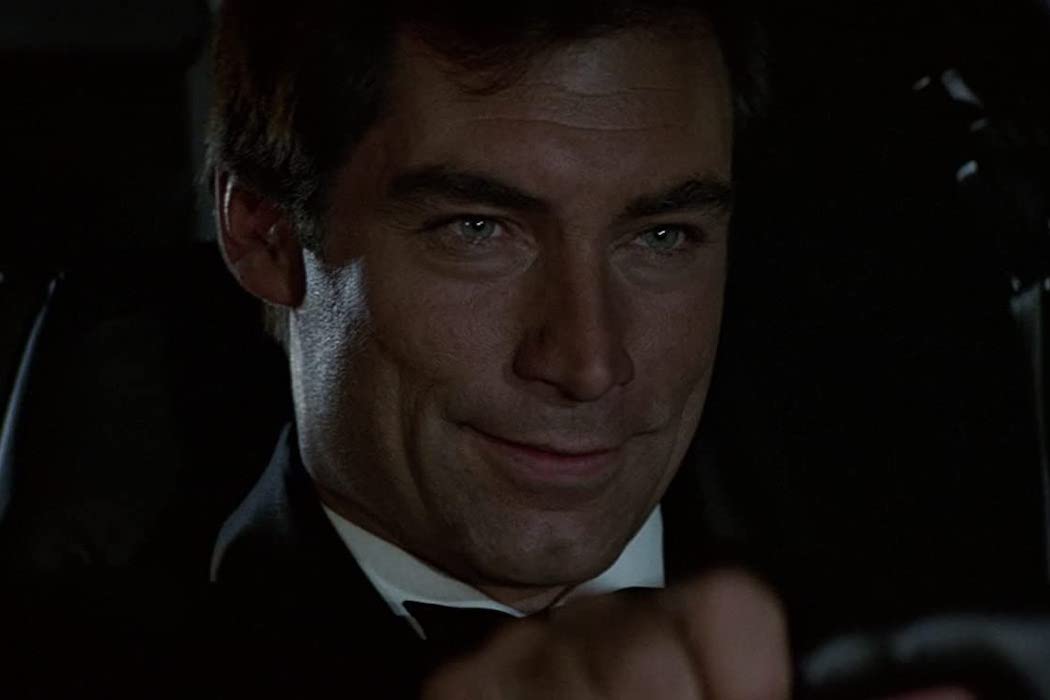
Movie lover & Los Angeles-based writer. BA in Film Criticism…
In the No Time To Die Countdown, Jake Tropila takes a look back at every Bond film – official and unofficial – in anticipation of the release of the latest entry.
First impressions are critical in the world of Bond. You may only live twice, but you get just one shot at making your grand entrance count. Consider Connery’s first moments onscreen in Dr. No. The reason why the legacy of Bond has endured for as long as it has is because no actor, in the history of cinema, has ever succeeded in looking as cool as he did in this very instance, casually lighting a cigarette and drolly responding to Miss Sylvia Trench’s innocent inquiry. As far as character introductions go, it cannot be topped.
Equally essential to the success of a Bond’s first outing is the quality of the film that surrounds him. Consider On Her Majesty’s Secret Service. Audiences may not have warmed up to Lazenby, but the production design in that film is first-rate; as far as the franchise goes, it’s one of the richest in that regard, with everyone behind the camera bringing their A-game to the picture. And formally speaking, Moore’s films had a lightness in touch, but could never quite hold a candle to something like From Russia with Love. For a Bond to truly excel, it needs to fire on all cylinders.
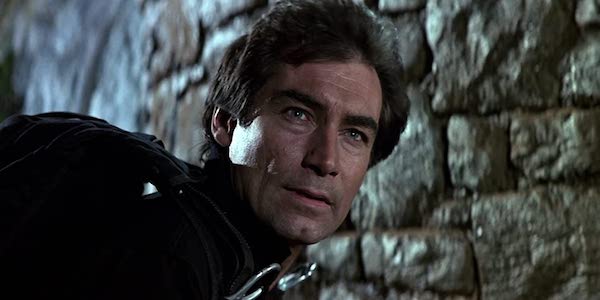
Which is why The Living Daylights ranks as one of the best films in the bunch, and it all starts with the leading man. If ever I were to boldly proclaim something as if it were an objective fact, it’s this: Timothy Dalton is the greatest actor to have ever filled the role of Bond. While only appearing in two films, Dalton succeeded in capturing the very essence of Fleming’s agent: the tortured existence, the dissatisfaction of duty, the sobering sense of awareness to the ugly world they inhabit. Following seven lighter Moore films, Dalton emerges as a real breath of fresh air. Connery may have entered the franchise walking and talking as James Bond, but Dalton delivers the best iteration of what Bond can be.
The rest of the film largely follows suit. With a few minor exceptions, The Living Daylights plays as a grand experience, offering one of the series’ strongest efforts to date while also returning it to its spy roots. Things may get a little complicated, but the film itself does not mess around, and neither should we. Hop onto my downhill sledding cello case, friend. It’s 1987. Time to meet the new boss.
Enter Timothy Dalton
Here we go. The pre-title sequence makes for a thrilling short film: three 00 agents have been tasked with infiltrating the Rock of Gibraltar to test the island’s stationed defenses. The film deliberately obscures the faces of all three agents, adding an air of question as to who our new leading man is. His reveal is completely satisfactory: following the cries of a 004, Dalton sharply turns into focus, his gaze steely and hair flowing in the breeze. Connery would be proud.
The rest of the sequence goes through familiar beats, but there’s a bit more vigor added with Dalton’s proclivity for doing his own stunts. The hunt for the assassin turns into a hectic car chase down the side of a mountain, utilizing a truck conveniently filled with explosive crates. Bond’s attacks are more vicious than most (is this the first time we see him deliver a headbutt?) and the foe is dispatched in a fiery blaze. Bond lands safely on some babe’s yacht and regretfully reports to MI6 that he will need an extra hour to report back to the office. All in a day’s work.
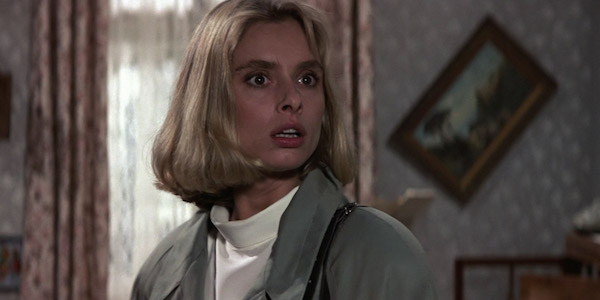
Two things I want to touch on with the latter moments of this sequence that I don’t think quite work as intended. First, there’s the delivery of “Bond, James Bond,” said when Bond introduces himself to the aforementioned Yacht Babe. Dalton, ever committed to excising the opulence out of a government agent with a license to kill, underplays the line to a degree that makes it sounds totally tossed off (as it would). Admirable in theory, except that the line is underplayed too well, making the entire choice seem a bit more mannered than intended. My opinion? Cut it completely, and you’d be fine without it.
The second is Yacht Babe’s invitation for some steamy, post-mission sex, and Bond’s immediate acceptance. Now, this is not out of character for Bond — Connery, Lazenby, and especially Moore would absolutely put the girl ahead of the mission — but it is out of character for Dalton, whose Bond would clearly not be into this sort of thing. These are minor quibbles, both of which stemming from predetermined obligations to franchise expectations. Don’t worry; good times lie largely ahead. Onto the song.
Following the might of Duran Duran’s title track might seem like a suicide pass, but a-Ha’s tune more than holds its own. The groovy beat and soothing warble of frontman Morten Harket’s Norwegian lilt make for a funky track and a good time – upper echelon, if you ask me. But the best part of the song is how it’s frequently incorporated into the film’s soundtrack. I haven’t mentioned him much in these retrospectives, but composer John Barry should receive full accolades here. Truth be told, he’s The Living Daylights’ stealth MVP, delivering one of the series’ finest scores in a film that would ultimately be his last. It’s no wonder he’s given a cameo as Kara Milovy’s orchestra conductor. So, thank you, John Barry. Your musical contributions have elevated Bond to the stuff of legends.
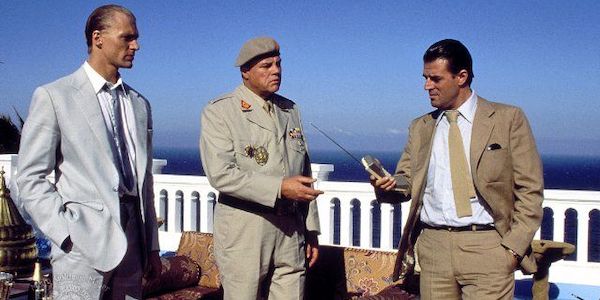
Speaking of orchestras, onto Bratislava. Bond’s mission begins in proper, aiding the defection of KGB General Georgi Koskov to the west, all during the intermission of a classical music concert. Bond is to eliminate any threats via sniper cover, spying one potential target in another sniper, who also happens to be an attractive blonde woman seen playing the cello in the concert. Recognizing her to be an amateur, Bond merely shoots the rifle out of her hand, allowing the mission to proceed, but not before being chewed out by stuffy Saunders, the Head of Section in Vienna and the brainchild behind Koskov’s planned defection, who vows to take this faux pas up with Bond’s superiors. Bond coldly retorts with the following:
*Stuff* my orders. I only kill professionals. That girl didn’t know one end of a rifle from the other. Go ahead. Tell M what you want. If he fires me, I’ll thank him for it. Whoever she was, I must have scared the living daylights out of her.
Magnificent. The perfect distillation of Dalton’s Bond, and he even drops the title of the movie. As classy and cool as they come.
Until Casino Royale came along, The Living Daylights was the final Bond Film to be directly adapted from a Fleming novel, or in this case, a Fleming short story. The entirety of the story is this sniper mission, right down to Bond’s final words after spotting a novice at the other end of his scope. The rest of the film expands greatly from here.
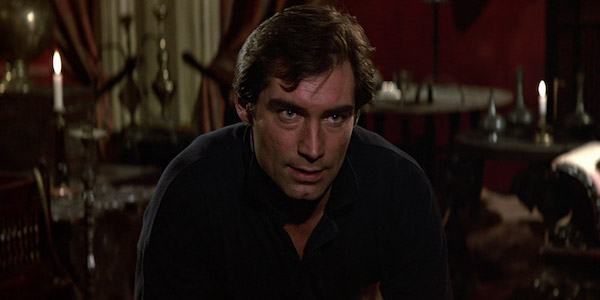
Koskov’s defection is a success, and the subsequent debriefing at an MI6 safehouse reveals that the new head of the KGB, General Leonid Pushkin, has reinstated “smiert spionam,” an operation to eliminate all known spies from American and British intelligence agencies, causing friction between Soviets and the West. Koskov demands that Pushkin be eliminated, lest tensions escalate further.
Before further truths and allegiances can be decided, Koskov is kidnapped nearly as soon as he defected by Necros, the deadly and aptly-named henchman. A hulking blonde with killer instincts (and our third iteration of Red Grant, for those keeping score at home), Necros scores big in The Living Daylights’ win column. His raid on the safehouse packs a punch – note his extended fight with an unnamed agent in the kitchen. The sheer brutality these two men throw at each other is a far cry from the days of Moore.
A Darker Breed of Bond
The search for Koskov forces Bond to play detective, and this is where Dalton truly shines. I could watch an entire film devoted to him wordlessly tailing leads, exchanging hard stares, and searching for clues in the unlikeliest of places. A strong, silent, existential assassin. This is my Bond.
Bond’s search leads him to Kara, the blonde cello player and would-be assassin of Koskov. Turns out, she’s Koskov’s girlfriend, and the rifle she was armed with was outfitted with blanks. Curious. Honestly, I rather like Kara. She feels real and gets the rare opportunity to be integral to the plot right from the inciting incident. Maryam d’Abo is also a bright screen presence and shares a nice rapport with Dalton, who gets to feel more relaxed when sharing the screen with her.
Many critics knock Dalton as being humorless Bond, but just take a look at the cut from him insisting Kara can’t bring her cello with them to him rubbing his forehead as he waits for her to retrieve it. Humorless? I think not. Plus, that cello case of hers comes in handy when you least expect it.

More on that in a moment. If there’s one subject I’ve neglected heavily in these revisits, it’s definitely the cars. Chalk it up to personal taste – I’m just not a car guy myself. Plus, after Goldfinger’s Aston Martin DB5, what more needs to be said? Fortunately, the Aston Martin V8 Volante makes a compelling case for second best, offering a sleek look while armed to the teeth with missiles, retractable ski skids, and sideways-firing laser beam.
We get to see all of these gadgets and more, in an extended chase with some angry Soviet troops. Director John Glen has a real eye for action, and not having to shoot around a stunt double for his leading man helps boost the quality of this sequence. The explosions pack a particular oomph – I love that random ice shack that gets turned into splinters – and there’s some nice humor in having Bond and Kara sled to safety on the open cello case (Bond tossing and catching the instrument over the boom barrier is a spectacular touch). A truly exceptional sequence that never overstays its welcome.
As it turns out, Koskov faked both his defection and his kidnapping. In reality, he’s in cahoots with Brad Whitaker, an American arms dealer with plans to outfit the KGB with the latest in his top-of-the-line weaponry. Above anything else, the villains make up the biggest stumbling block in The Living Daylights. Koskov is never really credible as a villain or ally, and Whitaker has too little screentime to make an impact in the proceedings. A real mixed bag of heavies, well below par for an ace Bond. Plus, their ultimate scheme is so perplexing that it has warranted repeated viewings for me to make any sense of it (more on that later).
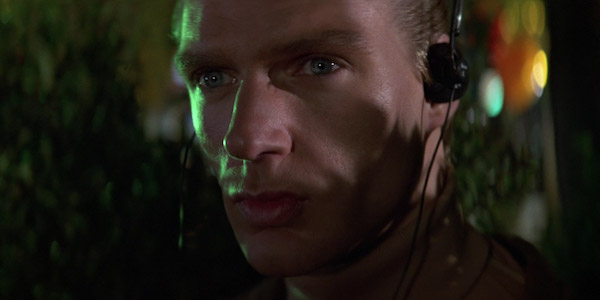
Thank god for Necros. The henchman gets his next big moment during the assassination of Saunders, the former stick-in-the-mud whom Bond (and us) find ourselves coming around to, right before he’s gruesomely crushed to death by a sliding glass door. Bond’s reaction is palpably intense; emotion gets the better of him, driving him to almost inadvertently murder a child in the middle of a crowded fairground. Loss, rage, regret, all experienced within seconds of each other. You look at Dalton holding back tears and tell me he’s not giving it his all. The best, I tell ya.
Bond’s confrontation of Pushkin offers more delicious cruelty. This is straight out of Fleming – a man at the mercy of Bond’s gun. One wrong move or one false word and the party’s over. The ugliness of exposing the wife to distract the armed detail is another crucial detail. Roger Moore feels like a distant memory at this point.
Going with his gut, Bond and Pushkin turn the tables on Koskov and the Gang, staging their own assassination to throw the heat off for a while. Pushkin had his own plans to purchase weapons from Whitaker. After months without delivery, he’s rescinded his order, suspecting foul play between Whitaker and Koskov. Well, as it turns out, Whitaker and Koskov were planning to use the funds from the KGB to acquire diamonds, which would then in turn be used to buy opium from the Mujahideen, and that will be sold to turn a profit and acquire the weapons from Whitaker. Phew!
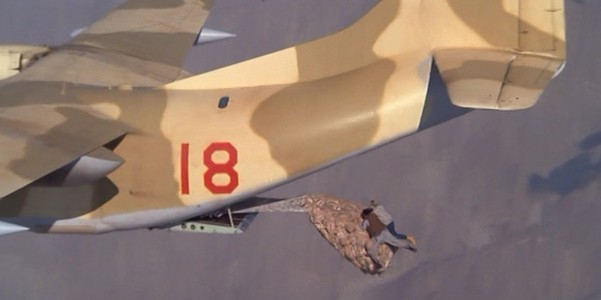
If you get lost during your first watch of The Living Daylights, you’re certainly not alone. All that’s needed to know is that the Soviets are looking to score big during a time of war. To prevent this, Bond teams up with the Mujahideen (in a Soviet-invaded Afghanistan) to foil Koskov’s opium deal, leading to a grand, action-packed climax that takes to land and air.
The best stunt sequence is saved for last, finding Bond and Necros hanging onto a net that is dangling precariously out of the back of a cargo plane, all while Kara tries to keep the aircraft level. The practical mix of stuntmen genuinely hanging onto dear life, several thousand feet in the air, and the actors safely operating in a controlled set is seamlessly woven together by Glen, who ratchets the excitement up to eleven. It’s a terrific bit of business, one worthy of Dalton’s inaugural Bond film, and it ultimately makes more than a fitting end to a formidable henchman.
Whitaker’s comeuppance doesn’t really register as much as it should, considering he’s practically a non-entity in his role as Bond Villain. Aided by Felix Leiter (played here by John Terry, Felix No. Seven), Bond infiltrates Whitaker’s compound and kills the oaf with an explosive keychain. We’re also deprived of any satisfying end for Koskov, who’s inferred to be executed offscreen sometime later. At least Bond gets to see Kara play her cello one last time. They’re sweet together.
Conclusion: The Living Daylights
The Living Daylights is extraordinary. The greatest Bond Actor gets an auspicious debut, harkening back to the strengths of Fleming and offering a richly detailed excursion in the world of 007. It’s a film that should have secured a long tenure with Dalton as Bond; as it stands, his run as Bond is already half-over. For all the cruelty offered in his films, this is perhaps the cruelest of them all. But there’s still one more of his films to look forward to, and I can assure you, it delivers on the promise made here.
Coming up next: leaving so soon, Mr. Dalton? Shame, we barely got to know each other. The No Time To Die Countdown will return with Licence To Kill.
Do you think Timothy Dalton is the best Bond ever? Let us know in the comments below!
Watch The Living Daylights
Does content like this matter to you?
Become a Member and support film journalism. Unlock access to all of Film Inquiry`s great articles. Join a community of like-minded readers who are passionate about cinema - get access to our private members Network, give back to independent filmmakers, and more.
Movie lover & Los Angeles-based writer. BA in Film Criticism & Media Theory from CSU Northridge. Unofficial Bond ally. Rhymes with “tequila.”












